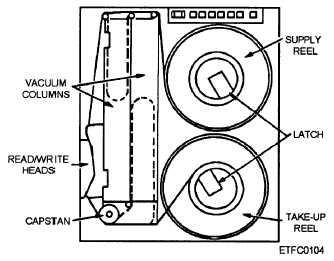Figure 9-7.—A windowed tape pack.
Current flow in a conductor can be
generated by a change in the magnetic lines of force
that cut through a conductor
Changing the current flow in a conductor
creates a change in the magnetic lines of force
radiating from the conductor
In other words, you can create current flow by
rotating (moving) a conductor in a magnetic (or
electromagnetic) field or by changing the distance
between a conductor and the source of magnetic
flux (field lines).
These principles allow for the creation of a
magnetized spot (flux pattern) on a magnetic
material (magnetic oxide surface). The magnetized
spot is created by the magnetic field surrounding a
current-carrying
conductor
in
the
immediate
proximity to the material. Moving the magnetized
spot rapidly by a conductor will generate current
flow in the conductor. Thus data may be written on
the surface of a magnetic material as it moves under
a current-carrying conductor (write head); data may
be sensed from the magnetized surface as it passes
under a conductor (read head) and generates current.
Recording Methods
The direction of the magnetic flux patterns
written on the magnetic oxide surface maybe used
to represent binary values. In other words, a flux
pattern magnetized in one direction might indicate a
binary ZERO, while a pattern magnetized in the
opposite direction would indicate a binary ONE.
This method of recording data is known as the
return-to-zero (RZ) recording technique.
Another recording method changes the direction of
the flux pattern when a binary ONE is to be stored. When
data is read from the magnetic oxide surface, a change
influx pattern direction indicates a binary ONE, while
no change indicates a binary ZERO. This method of
recording data is known as non-return-to-zero (NRZ).
NRZ is more commonly used than RZ because it lends
itself to higher bit densities on the recording surface.
A third recording method found in many newer
devices is known as phase encoding (PE). This
method uses very narrow spikes of current to write
extremely small flux patterns on the magnetic oxide
surface. Very accurate timing pulses are required to
read PE data spikes from the magnetic oxide surface.
The PE recording method provides the highest data
density of any recording method commonly in use.
Writing/Reading Magnetic Tape
The purpose of any magnetic tape unit is to write
data on and read data from the tape used by the device.
Tape is moved from a supply reel or hub to a take-up
reel or hub on the magnetic tape transport section of the
unit as shown in figure 9-8. The magnetic oxide coated
side of the tape passes in close proximity of a read/write
Figure 9-8.—A magnetic tape transport
9-7




